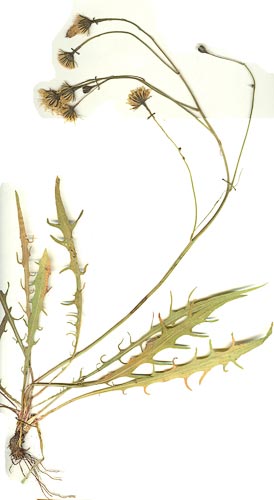Weeds
Leontodon autumnalis L. - Autumnal Hawkbit, Fall Dandelion.
Systematic position.
Family Asteraceae (Compositae), genus Leontodon L.Synonyms.
Scorzoneroides autumnalis Moensh, Apargia autumnalis Hoffm., Oporinia autumnalis D. Don.Biological group
Summer-green perennial short-rhizome plant.Morphology and biology.
Stalks are single or not numerous, 2-5 in number, 15-35 (60) cm in height, glabrous or seldom pubescent with simple hairs, usually without stem-leaves, slightly arcuated, not hollow, usually ramified in the upper part, less often simple. All leaves are arranged in a basal rosette; they are linear or narrow-lanceolate, 5-28 cm in length and 1-4 cm in width, glabrous or poorly pubescent with simple hairs, pinnatisected or pinnatipartite with linear lobes, or emarginated-dentate. Peduncles are tough, with small scale-like bracts, thick and hollow under calathidium , upright before flowering, drooped after flowering. Calathidia are single or 2-4 in number, 10-35 mm in diameter. Florets are yellow, ligulate, 10-18 mm long. Receptacle is flat, bare or rough. Involucre is oblong, imbricate, 5-10 mm in width and 10-15 mm in length, white web-like pubescent, with impurity of simple dark hairs. Leaflets of involucre are grayish and sharp. External leaflets are short and lanceolate, internal ones are long and linear-lanceolate. Achene is narrow and oblong, 4-5 mm in length, 0.5-0.6 mm in width, and 0.3-0.4 mm in thickness, dark brown, is longitudinally ribbed and cross-wrinkled, with truncated top, narrowed toward ends. Pappus has plumose hairs, yellowish or brownish, 5-8 mm in length. The plant blossoms since late summer or autumn till November. Reproducing by seeds. The plant winters as small rosettes.Distribution.
This European boreal species is described from Europe. General distribution includes temperate zone of Europe. The species is brought to Northern America. In the former USSR it is distributed in all the European part (except for Crimea), Ciscaucasia, and the south of Western Siberia. The species is brought to the south of Eastern Siberia and the Far East.Ecology.
In natural places the plant is common in grassland including hills and upper level of salt marshes. Also it frequently grows among bushes, on clearing and forest edges. In anthropogenic places the plant is common on garbage places, pastures, along roads and railways, on fallow lands, and in kitchen gardens. The plant litters crops of grain and perennial grasses, but being rare and not abundant.Economic significance.
The plant litters mainly crops of winter grain and perennial grasses. The weed is nocuous in zone of mixed fir and broad-leaved forests in western areas of flax growing, where it litters to 18% of fields. Control measures. Regularly destroy rhizomes of the weed with the help of appropriate types of soil treatment and herbicides. Do not contaminate sowing material or ground by seeds of the weed. Mow off or pull up the weed before fructification. Agronomical actions are directed to the weed weakening, using periodic pruning of roots. It is necessary to remember that the good result in struggle against the weed can be only reached at combination of agronomical and chemical methods.Related references.
Keller B.A., Lyubimenko V.N., Maltsev A.I., Fedtshenko B.A., Shishkin B.K., Rodzevich R.Yu., Kamenskii K.V., eds. 1935. Weed plants of the USSR. Moscow & Leningrad: AN USSR. V. 4. 414 p. (in Russian).Shlyakova, E.V. 1982. Keys to field weed plants of Non-Chernozem zone. Leningrad: Kolos. 208 pp. (in Russian).


